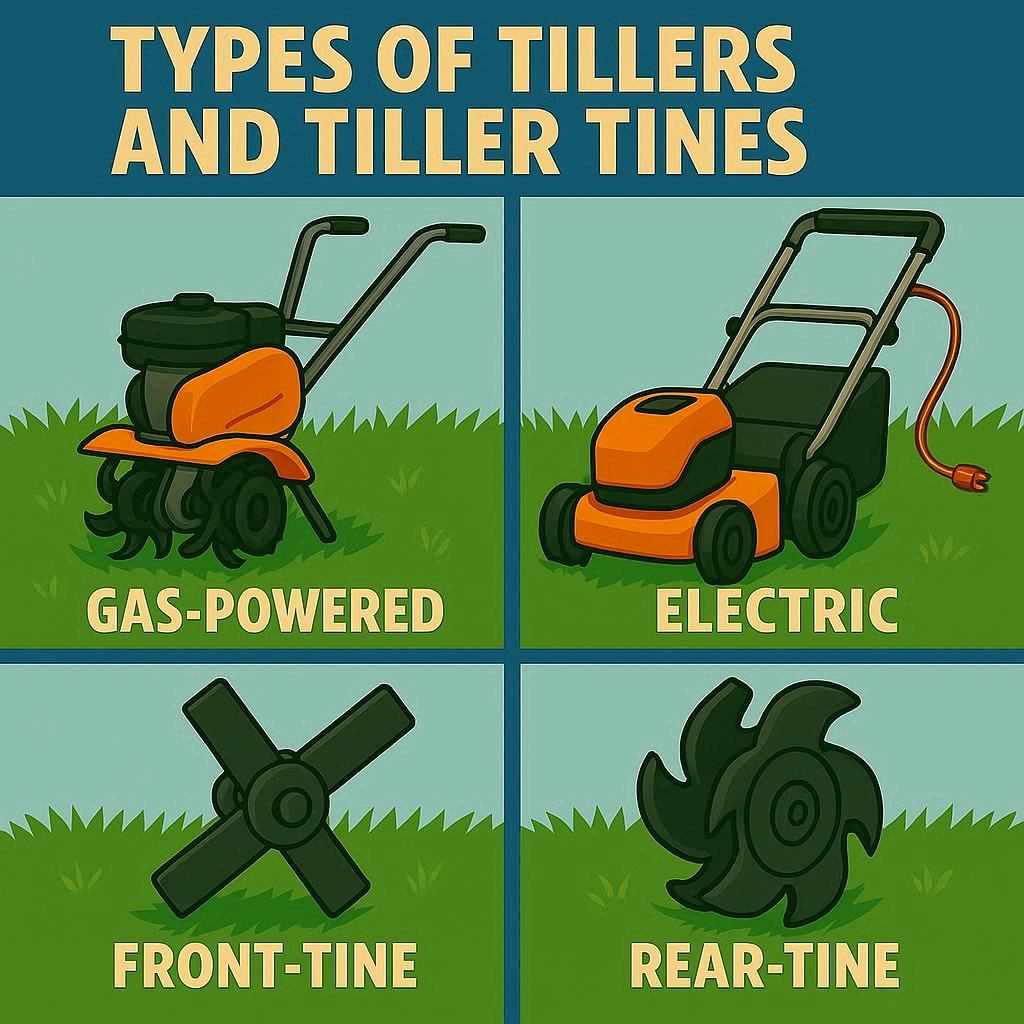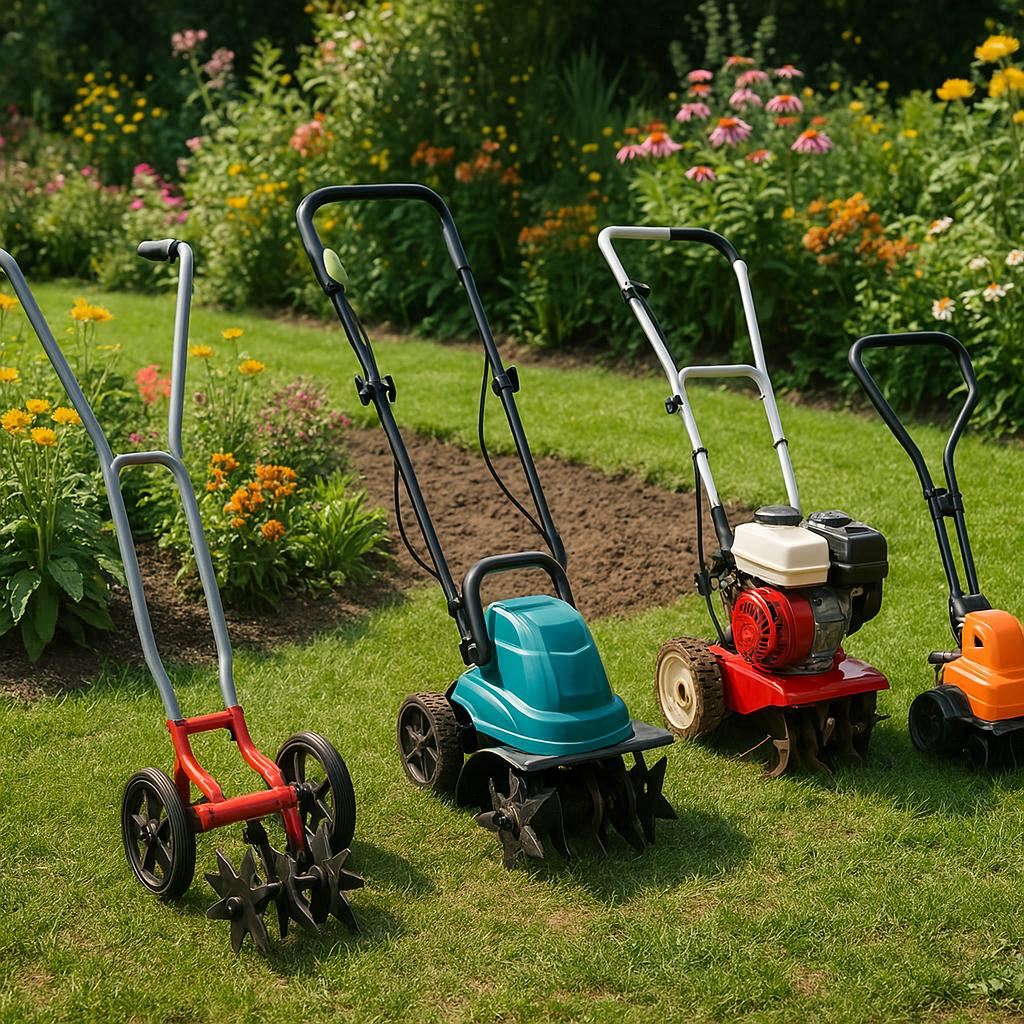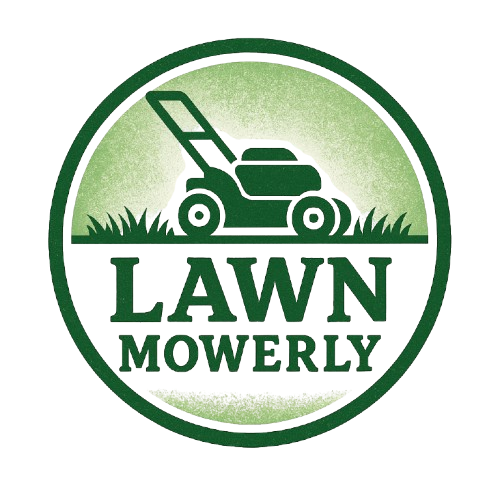
Tilling is one of the most essential steps in preparing soil for planting. It breaks compacted dirt, mixes organic matter, and helps roots breathe and grow freely. However, not all tillers are the same — and understanding their types (and the tine designs they use) helps you choose the right types of tillers for your yard, garden, or farm.
🚜 Types of Tillers
Tillers (sometimes called cultivators) are categorized based on size, power source, and tine placement. Here are the main types and how they differ:
1. Front-Tine Tillers
- Description:
In front-tine tillers, the rotating tines are located at the front of the machine, while the engine sits behind them. The wheels are powered indirectly, and the tines pull the tiller forward as they spin. - Best For:
Medium-sized gardens, flower beds, and light to moderate soil preparation. - Advantages:
- Easy to maneuver in small to mid-size spaces.
- Ideal for turning over previously tilled or loose soil.
- Less expensive and lighter than rear-tine models.
- Limitations:
- Can struggle in hard or rocky soil.
- Requires more physical effort to control and push.
- Example Uses:
Refreshing garden beds each spring or mixing compost into soil.
2. Rear-Tine Tillers
- Description:
Rear-tine tillers have the engine in the front and tines located behind the wheels. This setup provides better balance, traction, and deeper tilling power. - Best For:
Large gardens, compacted or heavy clay soils, and first-time tilling projects. - Advantages:
- Very powerful and stable.
- Adjustable depth settings and tine rotation modes (forward, counter, or dual).
- Excellent for breaking new ground.
- Limitations:
- Heavier and more expensive than front-tine models.
- Requires more space to maneuver.
- Example Uses:
Preparing new plots or tilling large vegetable gardens.
3. Mid-Tine Tillers
- Description:
The engine is positioned directly above the tines, balancing the weight evenly for smoother handling. - Best For:
Gardeners who want a blend of control and power. - Advantages:
- Balanced design for stability and reduced vibration.
- Easier to push and guide than front-tine models.
- Suitable for medium to large gardens.
- Limitations:
- Limited availability compared to front/rear-tine models.
- May still struggle in rocky soils.
4. Mini or Cultivator Tillers
- Description:
Compact, lightweight tillers powered by small gas or electric motors. They typically have narrow tines and shallow tilling depth. - Best For:
Small gardens, raised beds, or between-row weeding. - Advantages:
- Lightweight and easy to carry.
- Great for quick soil mixing and aeration.
- Requires little storage space.
- Limitations:
- Not suitable for breaking new or compacted ground.
- Less powerful motor and shallow depth (2–6 inches).
- Example Uses:
Aerating flower beds or working compost into topsoil.
5. Electric or Battery-Powered Tillers
- Description:
These tillers use electric cords or rechargeable batteries instead of gas engines. They are quieter, cleaner, and easier to start. - Best For:
Small to mid-size gardens where mobility or eco-friendliness matters. - Advantages:
- Low noise and zero emissions.
- Lightweight and low-maintenance.
- Instant start — no fuel or oil required.
- Limitations:
- Limited power and tilling depth.
- Battery or cord length can restrict use.
- Example Uses:
Urban gardening, backyard soil prep, or raised beds.
6. Gas-Powered Tillers
- Description:
Traditional tillers powered by small gasoline engines, offering high torque and deeper soil penetration. - Best For:
Large gardens, farms, or commercial landscaping. - Advantages:
- High power and deeper tilling capability.
- Works in hard, rocky, or clay-heavy soils.
- Available in multiple sizes (mini to heavy-duty).
- Limitations:
- Requires fuel, oil changes, and maintenance.
- Louder operation.
7. Two-Wheel or Tractor-Mounted Tillers
- Description:
Heavy-duty tillers attached to a walk-behind tractor or compact tractor’s PTO (power take-off). - Best For:
Farming, landscaping, and large-scale soil preparation. - Advantages:
- Extremely powerful and efficient for large areas.
- Adjustable tilling width and depth.
- Built to handle rough or virgin soil.
- Limitations:
- Very costly and requires experience to operate.
- Example Uses:
Field preparation, large garden beds, or soil restoration work.
⚙️ Types of Tiller Tines
Tiller tines are the rotating metal blades that dig, turn, and aerate the soil. The tine design determines how the tiller interacts with the soil — some chop aggressively, while others stir gently for seedbed preparation.
Here are the main types of tiller tines and their uses:

1. Bolo Tines
- Shape: Curved, scoop-like blades designed for deep tilling and soil mixing.
- Best For: Breaking new ground, clay soils, or heavy-duty tilling.
- Advantages:
- Penetrates deeply and turns soil thoroughly.
- Ideal for creating smooth seedbeds.
- Drawbacks:
- Can clog in very wet or sticky soil.
- Common Use: Rear-tine tillers for agricultural or large garden applications.
2. Slasher or L-Shaped Tines
- Shape: Sharp, L-shaped blades designed to slice through soil and roots.
- Best For: Shallow tilling, weeding, and mixing loose soil.
- Advantages:
- Works well in compacted or weedy soil.
- Excellent for surface cultivation without deep disturbance.
- Drawbacks:
- Less effective in breaking new, hard soil.
- Common Use: Front-tine or mini tillers.
3. Pick or Chisel Tines
- Shape: Narrow and pointed tips, designed for rocky or hard-packed soil.
- Best For: Breaking tough ground and loosening compacted layers.
- Advantages:
- Powerful digging action.
- Great for unworked soil and clay.
- Drawbacks:
- Leaves rougher soil texture; may need a second pass.
- Common Use: Heavy-duty or commercial-grade tillers.
4. Counter-Rotating Tines (CRT)
- Function Type: Not a shape but a rotation style — tines rotate opposite to the wheel direction.
- Best For: Penetrating hard or virgin soil since opposing motion increases traction and digging force.
- Advantages:
- Excellent soil breakup and depth.
- Works well for new gardens or dense terrain.
- Drawbacks:
- Harder to control; may throw soil backward.
5. Forward-Rotating Tines (FRT)
- Function Type: Tines rotate in the same direction as wheels, providing smoother motion.
- Best For: Light cultivation, aeration, and mixing.
- Advantages:
- Easier to control.
- Ideal for already-loose or previously tilled soil.
- Drawbacks:
- Limited digging depth and power.
6. Dual-Rotating Tines (DRT)
- Function Type: Switches between forward and counter rotation.
- Best For: Users who want flexibility for both deep tilling and light soil mixing.
- Advantages:
- Highly versatile.
- Excellent for gardeners working in varying soil conditions.
- Drawbacks:
- More complex mechanism; higher maintenance cost.
🌿 Choosing the Right Tiller and Tines
| Purpose | Recommended Tiller Type | Best Tine Type |
|---|---|---|
| Small flower or vegetable beds | Mini / Electric tiller | L-Shaped (Slasher) |
| Medium garden soil maintenance | Front or Mid-Tine tiller | Forward-Rotating Bolo |
| Breaking new ground | Rear-Tine tiller | Counter-Rotating Bolo or Pick |
| Compact or clay-heavy soil | Rear-Tine or Gas tiller | Chisel / Counter-Rotating |
| Weeding or surface aeration | Mini tiller or cultivator | L-Shaped |
| Large farm or field use | Tractor-mounted tiller | Bolo or Pick tines |
Certainly! Here’s a curated guide to popular tiller brands in the USA, categorized by their strengths and best-use scenarios:
🌱 Top Tiller Brands in the USA
1. Troy-Bilt
- Strengths: Renowned for durable walk-behind tillers, both rear- and front-tine models.
- Best For: Homeowners and small farms seeking reliable, mid-range tillers.
- Example: Troy-Bilt Colt FT 208cc 24″ Front Tine Tiller.
2. Earthquake
- Strengths: Offers powerful, compact tillers suitable for tough soil conditions.
- Best For: Gardeners needing robust tilling for compacted or rocky soils.
- Example: Earthquake Versa Front-Tine Tiller.
3. Ryobi
- Strengths: Produces battery-powered tillers with quiet operation and ease of use.
- Best For: Urban gardeners and those preferring eco-friendly tools.
- Example: Ryobi 40V HP Brushless 16″ Front Tine Tiller.
4. Mantis
- Strengths: Known for lightweight, compact tillers ideal for small spaces.
- Best For: Urban gardeners and those with limited storage.
- Example: Mantis 7940 4-Cycle Plus Tiller.
5. Greenworks
- Strengths: Offers battery-powered tillers with good runtime and performance.
- Best For: Home gardeners seeking reliable, eco-friendly options.
- Example: Greenworks 40V 10-Inch Cordless Tiller/Cultivator.
6. Honda
- Strengths: Produces high-quality, durable tillers with strong engines.
- Best For: Professional landscapers and large property owners.
- Example: Honda FG110 Mini-Tiller.
7. Craftsman
- Strengths: Offers a range of tillers known for reliability and value.
- Best For: Homeowners seeking dependable tools at a reasonable price.
- Example: Craftsman 4-Cycle Gas Tiller.
🔧 Best Tiller Brands by Use Case
| Use Case | Recommended Brand |
|---|---|
| Small Urban Gardens | Mantis, Ryobi |
| Compact or Clay-Heavy Soil | Earthquake, Honda |
| Budget-Friendly Options | Craftsman, Greenworks |
| Professional Landscaping | Honda, Troy-Bilt |
| Eco-Friendly Gardening | Ryobi, Greenworks |
🛠️ Tiller Features to Consider
- Tine Type: Choose between front-tine (lighter, easier to maneuver) and rear-tine (more powerful, better for tough soil).
- Power Source: Gas-powered for heavy-duty tasks, electric or battery-powered for lighter, quieter operation.
- Weight and Maneuverability: Consider the weight for ease of use and storage space.
- Adjustable Tilling Width and Depth: Allows customization for different gardening needs.
- Warranty and Support: Check for manufacturer warranties and customer service availability.
Here are some of the most popular tiller brands in the USA—along with what they’re known for, their product strengths, and what sets them apart. If you like, I can also give you a price-comparison chart or a “best by use” list.
🇺🇸 Popular Tiller Brands in the USA
| Brand | What It’s Known For / Strengths |
|---|---|
| Troy-Bilt | Very well-known for walk-behind tillers, both rear-tine and front-tine. They make durable models, decent power, parts availability is good. Often seen in home-gardens and small farms. (Remodel or Move) |
| Husqvarna | Strong in the higher-end/ heavier duty tiller market. Known for good build quality, reliable engines, good design. They also often partner with well-known engine makers (Honda, Briggs & Stratton) for reliability. (Know It All Learning) |
| Craftsman | More of a mid-range brand. Good mix of value + performance. Often targeted at homeowners rather than commercial users. |
| Earthquake | Known for heavy duty, aggressive tilling, especially for breaking ground, tough soil. Their tillers are often praised in reviews for depth and ability in hard soil. (The Spruce) |
| Champion Power Equipment | Offers fairly powerful front-tine tillers, good width, good for larger gardens. Often value-oriented in terms of price vs performance. (The Gardening Dad) |
| Mantis | Compact & USA-made in many cases. Used a lot for smaller gardens and folks who want lighter, more maneuverable cultivators/tillers. (Made in the USA Matters) |
| Sun Joe / Earthwise / Greenworks | These are strong in the electric / battery / corded tiller / cultivator sector. Good for light duty, smaller gardens, lower noise, less maintenance. Not always for hard or deeply compacted soil. |
| Southland Power Equipment | A name that comes up in several reviews for decent quality garden-tillers and cultivators. Useful for mid-sized jobs. |
🌻 Final Thoughts
Choosing the right tiller depends on your garden size, soil type, and intended use.
- For small gardens, mini electric tillers with L-shaped tines are perfect.
- For deep soil work or clay-heavy ground, go with rear-tine tillers equipped with bolo or counter-rotating tines.
- Always maintain your tines — keep them sharp, clean, and rust-free to ensure consistent soil performance.

I’m David man behind Lawn Mowerly; I’ve been dealing with lawnmowers and Tractors with my father since I was a kid. I know every make and model and what each one is capable of and love helping people find the perfect equipment for their needs.
